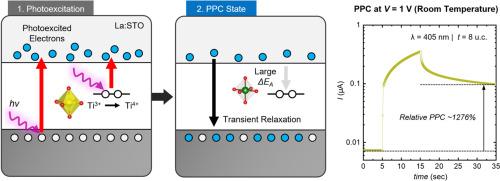电子-晶格耦合释放引发电子掺杂SrTiO3的巨大持久光电性
IF 14.3
1区 材料科学
Q1 MATERIALS SCIENCE, MULTIDISCIPLINARY
引用次数: 0
摘要
钛酸锶由于其多用途的电子性能和与阳离子掺杂的相容性而成为一种很有前途的氧化物基电子材料。本文研究了超薄La掺杂SrTiO3 (La:STO)薄膜的巨持久光电导率(PPC)。我们证明,与传统的基于氧空位的PPC机制不同,通过激活La:STO薄膜表面附近的Ti离子上的电子,可以触发强而强健的PPC,其中电子-晶格耦合起着关键作用。具体来说,对于8单元厚的La:STO薄膜,在波长为405 nm的紫外线(UV)照射下,ti相关的PPC达到1,276%。这种PPC状态保持高度稳定,在室温下完全释放需要24小时以上。我们的第一线原理密度泛函理论计算和与厚度相关的光电流分析一致表明,这个巨大的PPC来自于位于La:STO层表面附近的Ti3+O6八面体上激活的电子。这些结果表明,过渡金属氧化物中的电子-晶格相互作用可以产生强的PPC特性,这表明未来在低维光电器件中的应用。本文章由计算机程序翻译,如有差异,请以英文原文为准。

Giant persistent photoconductivity in electron-doped SrTiO3 triggered by release of electron-lattice coupling
Strontium titanate has emerged as a promising material for oxide-based electronics due to its versatile electronic properties and compatibility with cation doping. This study investigates the giant persistent photoconductivity (PPC) in ultrathin La-doped SrTiO3 (La:STO) films. We demonstrate that, unlike conventional PPC mechanisms based on oxygen vacancies, a strong and robust PPC can be triggered by activating electrons localized at Ti ions near the surface of La:STO films, where electron-lattice coupling plays a pivotal role. Specifically, for the 8-unit-cell-thick La:STO films, the Ti-related PPC of 1,276% is achieved under exposure to ultraviolet (UV) light with a wavelength of 405 nm. This PPC state remains highly stable, with full release taking more than 24 h at room temperature. Our first-principles density functional theory calculations and thickness-dependent photocurrent analysis consistently reveal that this giant PPC originates from electrons activated at Ti3+O6 octahedra located near the surface of the La:STO layer. These results demonstrate that electron-lattice interactions in transition metal oxides can give rise to strong PPC characteristics, suggesting future applications in low-dimensional optoelectronic devices.
求助全文
通过发布文献求助,成功后即可免费获取论文全文。
去求助
来源期刊

Journal of Materials Science & Technology
工程技术-材料科学:综合
CiteScore
20.00
自引率
11.00%
发文量
995
审稿时长
13 days
期刊介绍:
Journal of Materials Science & Technology strives to promote global collaboration in the field of materials science and technology. It primarily publishes original research papers, invited review articles, letters, research notes, and summaries of scientific achievements. The journal covers a wide range of materials science and technology topics, including metallic materials, inorganic nonmetallic materials, and composite materials.
 求助内容:
求助内容: 应助结果提醒方式:
应助结果提醒方式:


